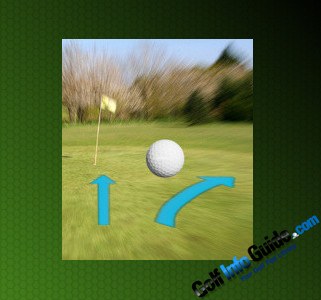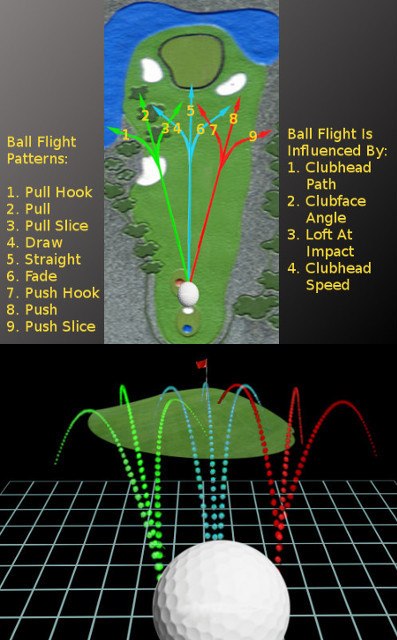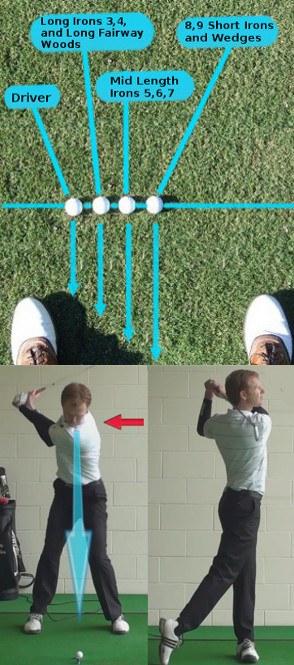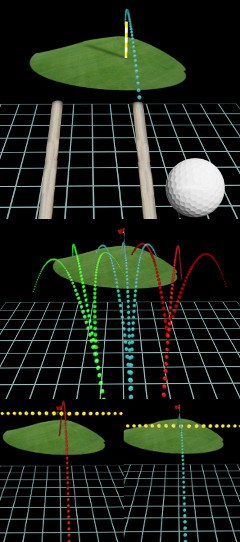In golf, it is relatively common for right-handed players to miss the target to the right.

In fact, you won’t think anything of it when you or someone else in your group misses to the right, as these kinds of shots happen all the time. But are all misses to the right created equal? Not even close. Some shots that miss to the right are the result of a fade or a slice, while others are blocked. If you don’t know the difference between those kinds of shots, we will clear up any confusion later in the article.
While it’s easy for amateur golfers to get caught up in the desire to hit the ball as far as possible, this game is built around accuracy more than anything else. Most players seem to think that the key to finding lower scores is learning to hit the ball longer distances. That just isn’t the case in most instances. Sure, hitting longer shots can be helpful, but that concern should always be secondary to the goal of hitting the ball as accurately as possible time after time. If you can succeed at hitting your targets with regularity, you might be surprised to find how little distance you actually need to keep up. Also, thanks to the modern equipment technology that we are all able to use on the course, the clubs and balls do more work than ever before in terms of generating distance. In summary, try to set aside your worries about distance while working on your game – master the art of hitting targets and everything else will fall into place nicely.
If you are going to be consistently accurate with your golf shots, you’ll need to take the block out of your game to the greatest degree possible. You can’t completely eliminate blocked shots, of course, as bad shots are always going to pop up from time to time in this difficult game. However, if you work hard on your fundamentals and put yourself in solid positions throughout your swing, you should be able to stay away from blocked shots more often than not.
All of the content below is based on a right-handed golfer. That means the blocked shots we are talking about are shots which are missing to the right of the target. For a left-handed golfer, who would be blocking the ball to the left of the target, it will be necessary to reverse the instructions.
What is a Blocked Shot?

There are a few different ways to wind up missing your target to the right. It is important to understand that simply missing to the right does not mean that you have it a block. Maybe you did, but it’s also possible that you hit a fade, a slice, or you may have hit a straight shot and your aim was actually to blame. In this section, we are going to walk through the definitions of the various shots that can lead you to the right of your target. By knowing the what the different kinds of misses look like, you can accurately assess your performance and take the right steps to get back on track.
Let’s get right to work explaining the different types of shots that can take your ball to the right of your intended target.
- A block. We might as well start with the shot that is the focus of our article. You already know that a block is a shot that misses to the right of the target, but is that the whole story? Not quite. When most golfers say they hit a ‘block’, what they mean is that they hit a shot which started to the right of the intended target and then flew mostly straight until it came back down. This is not a shot that curves wildly in the air, even though it might end up missing the target by quite a significant distance. The issue here is not one of shot shape, but rather of starting line. You’ve started the ball on the incorrect line when you hit a block, so even though the ball flies pretty straight, it still doesn’t end up anywhere near the target you had in mind.
- A slice. This is a shot that the majority of amateur golfers are closely familiar with. Most players have to go through a period where they fight a slight before they are able to get things straightened out. In fact, some players never do manage to work past the slice phase, as this can be one of the toughest golf swing issues to correct. Like a block, a slice will typically end up with the ball coming to rest well to the right of the target. However, where a blocked shot will fly mostly straight as it travels, a slice is going to curve dramatically from left to right. These types of shots are typically out of control, turning quickly to the right as soon as they take off. It should be noted also that a slice is often going to start to the left of the target line before the spin of the ball causes it to turn hard to the right. As we mentioned earlier, a block is a shot that starts right as soon as it leaves the club face, so that is another difference between these two kinds of misses.
- A fade. Basically, a fade is a more controlled version of a slice. This is still a shot that turns to the right in the air, but the spin rate is not so high as to cause the ball to curve wildly. Many golfers use the fade intentionally as their go-to ball flight, since this is very much a viable way to play the game. In fact, the fade is popular among professional golfers because of the control that it can offer the player when used correctly. If you do miss your target to the right with a fade, it may be that you simply faded the ball a bit more than you planned, or you may have aimed incorrectly. Either way, missing with a fade is a much different thing than missing with a slice, as the ability to hit a controlled fade demonstrates that you have a golf swing which is working pretty effectively.
- Good swing, poor aim. This last point on our list doesn’t get as much attention as it probably should receive. For many golfers, missed targets aren’t actually about poor swings at all – rather, they are about poor aim. It’s entirely possible that the shot you missed to the right of the target was the result of nothing more of aiming your body, and the club, too far to the right at address. Aiming at your intended target is a bit tricky in this game, especially because it is something that most golfers never bother to practice. Unfortunately, once the shot is over, there really isn’t anything you can do to go back and evaluate the quality of your aim. This is why it’s so important to work diligently on your aim during practice. If you consistently make this a point of emphasis as you work on your game, you can be confident on the course that your aim is not causing problems.
As you can see, it’s possible for your golf ball to wind up to the right of your target for many different reasons. It’s important to understand these possibilities because you don’t want to get to work on fixing a block when you aren’t even hitting a block in the first place. Take some time to analyze the misses you are struggling with in your game and make sure the block is actually a problem before you start making changes. If you do decide that a block is consistently giving you trouble on the course, the content in the rest of this article should be of assistance.
The Basic Problems

At this point, we have established that a block is a shot that starts to the right of the target and flies mostly straight until it comes down. That’s good information to have available, but it doesn’t really do you much good all on its own. You need to understand why this is happening, so you can then move forward and make the right changes. As is typically the case in golf, there is more than one potential cause of a blocked shot. In this section, we are going to highlight three possible causes for you to consider. There is a good chance that one of the three points below is at the heart of your problem with blocked shots.
- Getting stuck. The problem of getting stuck during the golf swing is one that impacts players of all levels, from beginners on up to professionals. Getting stuck means that the club is stuck behind you in the downswing, with your lower body turning through the shot while the club is still lagging too far behind. It’s a good idea to let your lower body lead the way in the golf swing, but you don’t want to get too carried away with this concept. If your lower body gets too far ahead, the club will be stuck behind you and a block is the likely outcome. The issue here is with the path of the club through the hitting area. Since the club is stuck behind you, it’s almost certain that you will swing from inside-out through impact, meaning the shot is going to start to the right of the target.
- Playing the ball too far back in your stance. This is a ‘sneaky’ way to wind up hitting a block. We say that it is sneaky because you likely won’t think of your ball position as a potential cause of a blocked shot to the right of the target. Even if you make a good swing from start to finish, you might end up with a block as a result of the improper ball position. When playing iron shots, make sure the ball doesn’t drift behind the midway point of your stance, and you may even want to play your shots from well in front of that point. For your driver and fairway woods, most players will find success playing the ball up near the front of the stance. It does take some experimentation to find the perfect ball position for each of your clubs but remember that playing the ball too far back can lead to a block.
- Sliding toward the target. When your golf swing is working properly, you should be rotating aggressively toward the target in the downswing. It is rotation, rather than lateral movement, that should be responsible for generating speed in your swing. For those who hit blocks on a consistent basis, it’s possible that the downswing is featuring too much of a lateral move to the left. If your backswing has plenty of rotation, but the downswing is too much of a lateral move, you’ll approach the ball from the inside and a block is one possible outcome.
It is during this portion of the process when you should start to understand how you are going to go about fixing your blocked shots. Review the list above and think about the way you swing the club. Do any of these issues seem like a possibility in your game? Most likely, it won’t take long for you to think this through and figure out why you are blocking the ball. Next up? We’ll discuss some solutions to this frustrating issue, so you can get your game back on track as soon as possible.
The Basic Solutions

You shouldn’t need to do anything particularly complicated in order to work the block out of your golf game. In fact, you should intentionally seek out simple fixes, as those are going to be the most likely to lead to prompt and long-lasting results. If you attempt to completely overhaul your swing in order to straighten out the block pattern, it’s likely that you’ll wind up doing more harm than good. With the tips below, we have kept things simple in an effort to get you thinking along the right lines.
- Address ball position issues promptly. Obviously, if you think that your ball position is to blame for your blocked shots, you will want to work on this issue right away. Not only can improving your ball position help to take the blocked shots out of your game, but it can also help you improve your trajectory, add distance, and control the amount of spin you place on the ball. Spend some time on the range trying out various ball positions and take notes as you go to see what kinds of changes lead to what kinds of results. It’s a good habit to review your ball position periodically to make sure you are still playing form a position that promotes quality ball striking throughout your bag.
- Check on your finish position. We mentioned in the previous section that a lateral slide in the downswing can lead you to hit a blocked shot. Since that is the case, it is worthwhile to check on your finish position to make sure that you are rotating rather than sliding on the way down. When you finish your golf swing, you should feel that the majority of your weight is stacked on top of your left foot, with your right toe resting gently on the ground. The left leg should be straight, and your chest should be facing the target. If you have slid too much in the downswing, your left leg will be bent slightly, and you probably won’t have turned enough to face your chest toward the target. Hold your finish after each swing and analyze your position to determine if you are doing a good job with your downswing rotation.
- Shorten your arm swing going back. If you are going to avoid getting stuck in your downswing, it’s important that you stay away from an extra-long arm swing going away from the ball. Some golfers try to force their arms to go as far back as possible during the backswing, thinking that such a strategy will lead to an increase in power. Most likely, that is not going to be the case. Instead, that long arm swing will cause the club to lag too far behind in the downswing, and the club will be stuck. You don’t have to dramatically shorten the length of your backswing but try tightening it up a bit, so it better matches with your shoulder rotation. If you can manage to stop the rotation of your shoulders and the swinging of your arms at the same time, you’ll be in great shape.
In the end, the solution you use to solve the problem of blocked golf shots is going to have to be tied directly to the underlying cause of the issue. With any luck, at least one of the three points above will help you move in the right direction, and you can set your blocked shots struggles behind you sooner rather than later.
Monitoring Progress in Practice

One of the important skills you need to learn as a golfer is the ability to monitor your progress in practice. If you don’t pay close enough attention in practice to the quality of your swings and the resulting ball flights, you’ll never know if you are making the right changes. So, how do you know if you are improving with regard to blocked shots? Well, for starters, you need to pay attention to how many blocked shots you are hitting in practice (obviously). If you are only hitting a few blocked shots in an entire practice session, you can feel pretty good about things. On the other hand, if every other shot is blocked to the right, you’ll know that plenty of work is still left to do.
Another way to monitor progress is to pay attention to the way your swing feels and your confidence in the moves you are making through the ball. At first, if you have made some changes to your technique, you won’t feel particularly comfortable or confident. And that is okay. It will naturally take time to work your way into this new swing. So, as you continue to practice, pay attention to whether or not your confidence in the swing technique is improving. If it is, that’s another good sign that you are moving in the right direction. If the swing continues to feel awkward, however, there is probably a reason for it. What are you asking yourself to do in the swing, and is it too far outside of what comes naturally to ever work consistently? Don’t fight yourself for too long – if a particular move or technique keeps feeling uncomfortable, you may need to approach this problem from a new angle.
As you practice your swing, no matter what you happen to be working on, remember that it is always important to pay attention to the small details. Pick specific targets, do your best to aim accurately at those targets, and then evaluate the outcome of each shot. By monitoring closely both what you are trying to do and how well you are doing it, you should have a relatively easy time making progress over the long run.
It is frustrating to consistently block your shots to the right of the target. You might feel like you are making good swings, only to look up and see the ball sailing way to the right. Don’t let this issue cause too much frustration, however, as some hard work and critical thinking can get you back on track in the near future. We hope the information provided in this article will help you sort through the blocked shot problem and begin to lower your scores in upcoming rounds. Good luck!
Obviously when you ask most people what the best type of golf shelter hit is, is generally going to be sort of the draw shot. A right to left for the right hander is the preferred shape moving from right to left down the fairway, particularly, nice to see when you hit a driver. But most people that manage that draw shot from right to left, they’re often played by one particularly bad shot which is a block or sometimes even a push blocked slice. Something that starts off right of the fairway, goes right of the fairway, and cuts even further. Then that shot is actually caused by the very same swing that can cause your draw shot, but just with a slightly misaligned and mistimed club face position. So if you’re trying to draw the golf ball, you’re probably trying to get the golf club to come slightly from the inside the line and bringing the club down on the inside line is a good thing. But if you then have the club face open to that swing path, the ball will start right and it will move further right, and that’s going to get you into trouble.
If you’ve got the club coming down on an inside line with a square club face, square to the path, that’s a bit of a block, close to the path, you’ll start to draw the golf ball and curve the ball from right to left as you want. But if you get this position where you’re trying to draw the golf ball, but instead you’re getting pushy and blocks and slices or block slices from that position, we’ve got to question whether the club face and the body is synced up together. We’ll also got a question whether your ball position is correct.
If you’re driving the golf ball and we have the ball positioned too far back, you’re simply not allowing the club face enough time to square itself up to the path or square itself up to the target line. It would generally be in an open position at this point if the ball position is too far back leaving the ball away to the right hand side. So check that your ball position with your driver is nicely up to your front side.
Then another problem with the block shot is when people turn out of the shot too quickly or sliding to the ball too quickly. Sliding into the golf ball, drops the club too much on the inside line behind them, the club face can’t square up and it’s pushed away down the right hand side as a pusher or push slice.
So here’s a little exercise for you. You set your feet up around about one foot width apart and just practice hitting golf balls like this. By having your feet nearer together, you’ll generally make the hips stop sliding quite so much and start rotating a little bit more just helping you balance and synchronize every movement now. So the hips, the chest, the shoulders, the hands and the arms will all get a bit more synchronized in their rotational movements rather than this very aggressive slide and recover action that you might be using to draw the golf ball. We want everything to be nicely working in unison.
So if you’re blocking the golf ball and a blocker, a block slice is right, going further right, instead of right to left as the draw that you would like consider ball position, consider an unsynched down swing where the face is open to the path and we want to try and get everything turning through a little bit better. Feet one foot width apart, practice swings like that, just hitting little sort of half speed drivers and then gradually, build that up and just be conscious to everything turns through together to produce a solid impact position to get you back to hitting that excellent draw shot.





